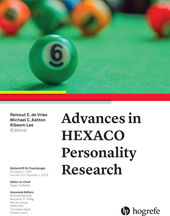The Nature and Nurture of HEXACO Personality Trait Differences
An Extended Twin Family Study
Abstract
Abstract. This study was designed to provide detailed estimates of genetic and environmental sources of variance in the HEXACO personality traits. For this purpose, we analyzed data from a German extended twin family study including 573 pairs of twins as well as 208 mothers, 119 fathers, 228 spouses, and 143 offspring of twins. All participants provided self-reports on the HEXACO-60. Extended twin family analyses using structural equation modeling (SEM) yielded that additive and nonadditive genetic influences accounted for about 50% of the variance in personality traits. The remaining variance was primarily due to individual-specific environmental sources and random measurement error. Spousal similarity in Openness was attributable to assortative mating, whereas spousal similarity in Honesty-Humility was attributable to environmental circumstances, partly due to a shared social background and spouse-specific effects. Our analyses yielded specifics for different personality traits. However, transmission of trait similarity from one generation to the next was primarily genetic.
References
(2007). Empirical, theoretical, and practical advantages of the HEXACO model of personality structure. Personality and Social Psychology Review, 11, 150–166. https://doi.org/10.1177/1088868306294907
(2009). The HEXACO–60: A short measure of the major dimensions of personality. Journal of Personality Assessment, 91, 340–345. https://doi.org/10.1080/00223890902935878
(2018). A nuclear twin family study of self-esteem. European Journal of Personality, 32, 221–232. https://doi.org/10.1002/per.2136
(2018). An extended twin-pedigree study of neuroticism in the Netherlands twin register. Behavior Genetics, 48, 1–11. https://doi.org/10.1007/s10519-017-9872-0
(2012). Broad bandwidth or high fidelity? Evidence from the structure of genetic and environmental effects on the facets of the Five Factor Model. Behavior Genetics, 42, 743–763. https://doi.org/10.1007/s10519-012-9548-8
(2005). Estimating the extent of parameter bias in the classical twin design: A comparison of parameter estimates from extended twin-family and classical twin designs. Twin Research and Human Genetics, 8, 214–223. https://doi.org/10.1375/1832427054253121
(1985). Personality and individual differences: A natural science approach. New York, NY: Plenum.
(2008).
Behavioral genetic studies of personality: An introduction and review of the results of 50+ years of research . In G. J. BoyleG. MatthewsD. H. SaklofskeEds., The Sage handbook of personality theory and assessment (Personality theories and models (Vol. 1, pp. 145–173). London, UK: Sage.(2012). Left or right? Sources of political orientation: The roles of genetic factors, cultural transmission, assortative mating, and personality. Journal of Personality and Social Psychology, 102, 633–645. https://doi.org/10.1037/a0025560
(2015). The genetic and environmental roots of variance in negativity toward foreign nationals. Behavior Genetics, 45, 181–199. https://doi.org/10.1007/s10519-014-9700-8
(2017).
Behavior genetics and personality development: A methodological and meta-analytic review . In J. SpechtEd., Personality development across the lifespan (pp. 473–495). Amsterdam, The Netherlands: Academic Press. https://doi.org/10.1016/B978-0-12-804674-6.00029-6(2010). Sources of variance in personality facets: A multiple-rater twin study of self–peer, peer–peer, and self–self (dis-) agreement. Journal of Personality, 78, 1565–1594. https://doi.org/10.1111/j.1467-6494.2010.00661.x
(2019). Unraveling the interplay between genetic and environmental contributions in the unfolding of personality differences from early adolescence to young adulthood. European Journal of Personality. Advance online publication. https://doi.org/10.1002/per.2189
(2017).
Theoretical perspectives on the interplay of nature and nurture in personality development . In J. SpechtEd., Personality development across the lifespan (pp. 101–115). Amsterdam, The Netherlands: Academic Press. https://doi.org/10.1016/B978-0-12-804674-6.00008-9(2014). Core and surface characteristics for the description and theory of personality differences and development. European Journal of Personality, 28, 231–243. https://doi.org/10.1002/per.1952
(2005). Quantifying and addressing parameter indeterminacy in the classical twin design. Twin Research and Human Genetics, 8, 201–213. https://doi.org/10.1375/1832427054253068
(2010). Are extended twin family designs worth the trouble? A comparison of the bias, precision, and accuracy of parameters estimated in four twin family models. Behavior Genetics, 40, 377–393. https://doi.org/10.1007/s10519-009-9320-x
(2009). Modeling extended twin family data I: Description of the cascade model. Twin Research and Human Genetics, 12, 8–18. https://doi.org/10.1375/twin.12.1.8
(2018). Is the personality – Politics link stronger for older people? Journal of Research in Personality, 77, 113–118. https://doi.org/10.1016/j.jrp.2018.10.003
(2010). The personality bases of socio-political attitudes: The role of Honesty–Humility and Openness to Experience. Journal of Research in Personality, 44, 115–119. https://doi.org/10.1016/j.jrp.2009.08.007
(2005). Personality traits beyond the big five: Are they within the HEXACO space? Journal of Personality, 73, 1437–1463. https://doi.org/10.1111/j.1467-6494.2005.00354.x
(2014). How genes influence personality: Evidence from multi-facet twin analyses of the HEXACO dimensions. Journal of Research in Personality, 51, 9–17. https://doi.org/10.1016/j.jrp.2014.04.004
(2006). The mechanism of emergenesis. Genes, Brain, and Behavior, 5, 306–310. https://doi.org/10.1111/j.1601-183X.2006.00233.x
(1992). An introduction to the five-factor model and its applications. Journal of Personality, 60, 175–215. https://doi.org/10.1111/j.1467-6494.1992.tb00970.x
(1984). Adjustment of twin data for the effects of age and sex. Behavior Genetics, 14, 325–343. https://doi.org/10.1007/BF01080045
(2009). Modeling extended twin family data II: Power associated with different family structures. Twin Research and Human Genetics, 12, 19–25. https://doi.org/10.1375/twin.12.1.19
(1973). Analysis of family resemblance I: Introduction. American Journal of Human Genetics, 26, 318–330.
(2014). Faktorenstruktur, psychometrische Eigenschaften und Messinvarianz der deutschsprachigen Version des 60-Item HEXACO Persönlichkeitsinventars
[Factor structure, psychometric properties, and measurement invariance of the German-language version of the 60-item HEXACO personality inventory] . Diagnostica, 60, 86–97. https://doi.org/10.1026/0012-1924/a000112(2012). Personality in childhood: A longitudinal behavior genetic approach. Personality and Individual Differences, 53, 411–416. https://doi.org/10.1016/j.paid.2012.01.019
(2008).
Exploring personality through test construction: Development of the Multidimensional Personality Questionnaire . In G. J. BoyleG. MatthewsD. H. SaklofskeEds., The Sage handbook of personality theory and assessment (Personality measuring and testing) (Vol. 2, pp. 262–292). London, UK: Sage.(2015). Heritability of personality: A meta-analysis of behavior genetic studies. Psychological Bulletin, 141, 769–785. https://doi.org/10.1037/bul0000017



